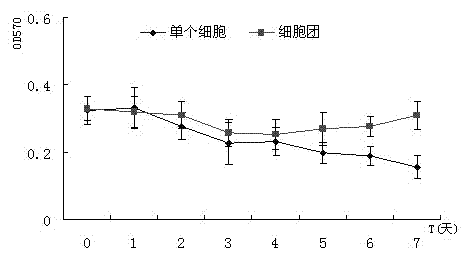Separation method for cell cluster having tumorigenic potential in liver cancer tissue
A separation method and cell cluster technology, applied in the field of tumor tissue cells and primary culture of tumor tissue cells, can solve the problems of separation and identification of liver cancer stem cell subsets, difficult to obtain viable cell sorting and identification, etc., and achieve the effect of narrowing the search range.
- Summary
- Abstract
- Description
- Claims
- Application Information
AI Technical Summary
Problems solved by technology
Method used
Image
Examples
Embodiment 1
[0089] Example 1: Sample basic information
[0090] All 36 specimens were taken from HBV-positive patients. The preoperative imaging diagnosis was all hepatocellular carcinoma patients with single tumor focus and clear border. The tumor diameter was 3.2cm-7.4cm (4.4±1.2cm), without vascular invasion and distant metastasis. There were varying degrees of fibrosis in the diseased livers.
Embodiment 2
[0091] Example 2: Cell and Cell Aggregate Activity
[0092] After using the above separation method, the suspension obtained is a mixture of single cells and cell aggregates of different sizes. Trypan blue staining shows that the blue-stained cells are 6 (1.312±0.464*10 7 ), trypan blue staining showed that the viable cells in the obtained cell suspension accounted for 95.7±4.5%. Take part of the obtained small group of tissues and further digest them to count the number of cells and calculate the total number of cells. This part of the cells is included in the statistical results. The average number of cells per gram of sample processed by this method is 1.625±0.324*10 7 cell. The number of cells in the small tissue block is 9-29 (23.8±6.9), which can be attached to the surface of the petri dish coated with rat tail collagen after being diluted to an appropriate multiple with the medium. The results of trypan blue staining showed that the viable cells accounted for 96.0±3...
Embodiment 3
[0093] Example 3: Expression of different proteins in liver cancer tissues
[0094] The results of immunohistochemistry showed that the anti-human hepatocyte antibody was positive in the hepatocellular carcinoma cell membrane in all 36 cases of liver cancer samples; CK19 was strongly positive in the bile duct epithelial cells: in the liver cancer tissues, most of the liver cancer cells were CK18 positive, and in the The cytoplasm and membrane of some cells scattered around the central vein were strongly positive for anti-CK18; consistent with our previous research results [1] , CD133-positive cells scattered in cords or clusters in liver cancer cells.
PUM
| Property | Measurement | Unit |
|---|---|---|
| diameter | aaaaa | aaaaa |
Abstract
Description
Claims
Application Information
 Login to View More
Login to View More - R&D
- Intellectual Property
- Life Sciences
- Materials
- Tech Scout
- Unparalleled Data Quality
- Higher Quality Content
- 60% Fewer Hallucinations
Browse by: Latest US Patents, China's latest patents, Technical Efficacy Thesaurus, Application Domain, Technology Topic, Popular Technical Reports.
© 2025 PatSnap. All rights reserved.Legal|Privacy policy|Modern Slavery Act Transparency Statement|Sitemap|About US| Contact US: help@patsnap.com



